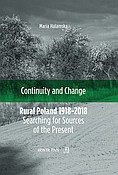Publikacje
Maria Halamska
Translated by Joanna Dutkiewicz-Kelburn
 |
Continuity and Change
|
Książkę można nabyć w Wydawnictwie Naukowym Scholar
Publication financed under the programme of the Minister of Science and Higher Education – „DIALOG” in the years 2017–2019
The partner in the project is the Central Statistical Office
The publication was supported by the European Fund for the Development of Polish Villages Foundation and the Rural Development Foundation
1. The aim of the monograph and its origins
The past 100 years in Poland has been a fascinating time of changes in all areas of life, including fundamental system transformations. Rural areas and agriculture have played a very important role in these changes. This monograph presents the author’s original synthesis of analyses carried out by many researchers as part of the interdisciplinary project Continuity and Change: One Hundred Years of Polish Countryside and Agriculture Development – Interdisciplinary Cooperation of Humanities and Social Sciences for Academic Dialogue. The aim of this project was to provide a multifaceted description of the processes forming the picture of the countryside’s changing role in Poland’s economic, social and cultural life in the 100 years since the country regained its independence, i.e. in the years 1918–2018. The several dozen studies produced in the project revealed the significance of one especially important – and numerically the biggest – actor of Polish history over the past century: the rural population, and, within it, the peasant population that was predominant for over half the period under analysis. Their contribution to Poland’s development deserves proper appreciation.
The project was carried out at the Institute of Rural and Agricultural Development of the Polish Academy of Sciences in 2016–2020. Those working on the project were, first and foremost, employees of the institute, but the collaborators included many leading scholars from other academic communities. Their work has resulted in several dozen studies published in three volumes of the collective monograph Ciągłość i zmiana: Sto lat rozwoju polskiej wsi [Continuity and Change: One Hundred Years of Polish Rural Development]. Those studies have been the main source material for the present synthesis; this multifaceted monograph could not have been produced without them. That is why the authors are given a voice many times in the text – to underline their contribution to this analysis, although it draws upon many other sources as well.
TABLE OF CONTENTS
INTRODUCTION 9
1. The aim of the monograph and its origins 9
2. The 19th century in the history of rural Poland, or the foundation of the present 10
3. The “longue durée” and ways of analysing it 12
4. Problems of analysis and description 15
1. THE RURAL POPULATION: EVOLUTION OF DEMOGRAPHIC AND SOCIAL STRUCTURES 21
1. Changes in the size and demographic structure of the rural population 21
2. Changes in educational levels and structure 28
3. Changes in the rural social-occupational structure 30
4. The rural population’s sources of livelihood 48
5. The rural population: rhythm(s) of evolution 54
2. THE RURAL ECONOMY: FROM AGRICULTURAL TO MULTIFUNCTIONAL 57
1. The rural economy, or… 57
2. Agriculture: its development and changing functions 61
3. The rural non-agricultural economy 92
4. The rural economy: mechanisms of change 95
3. RURAL COMMUNITIES 100
1. “Rural territories”: village, parish, territory of government 101
2. Residents: “our own” and “the other” 109
3. Institutions “that make the whole internally integrated…” 115
4. “A degree of mental cohesion” 141
4. THE RURALITY OF POLISH SOCIETY 145
1. Rural culture: peasant culture, folk culture, cultural patchwork? 146
2. Rural “politicking” 164
3. Rural space as a frame and moderator of social processes 178
4. Polish people’s issues with (their own) rurality 201
CONCLUSION: TIME, CHANGES, CONTINUITY IN THE EUROPEAN PERIPHERIES 203
1. Social time(s) 203
2. Change and continuity 204
3. The “social configuration of agriculture” in Poland’s 100-year history 208
4. Western universality or peripheral uniqueness? 215
BIBLIOGRAPHY 221





